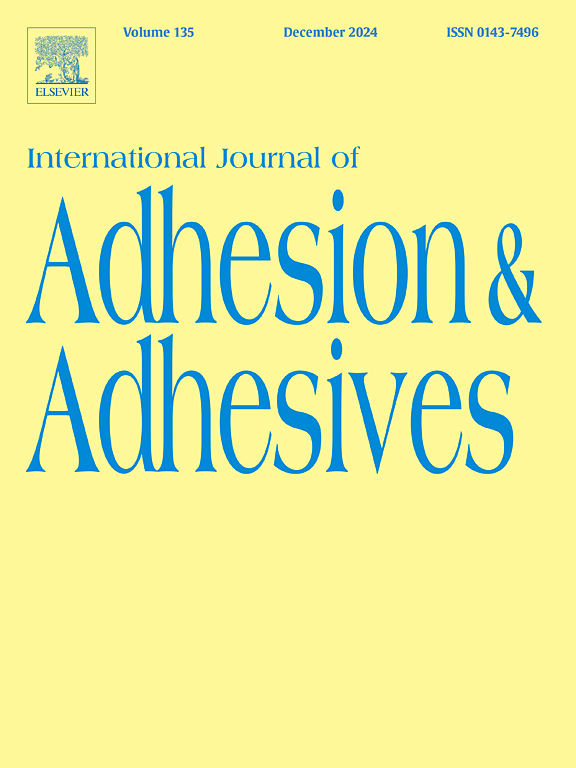采用定制界面几何形状的异种 FDM 印刷单搭接接头的强度改进和失效分析
IF 3.5
3区 材料科学
Q2 ENGINEERING, CHEMICAL
International Journal of Adhesion and Adhesives
Pub Date : 2024-11-01
DOI:10.1016/j.ijadhadh.2024.103876
引用次数: 0
摘要
熔融沉积建模(FDM)为热塑性塑料的设计提供了灵活性,使其适合特定的结构优化。混合接头结合了粘合剂粘接和机械互锁,可有效连接不同的热塑性塑料。本研究旨在通过了解失效机理以及延迟损伤的发生和扩展,来加固不同的 FDM 印刷单搭接接头(SLJ)。由于粘合刚度不同而产生的不对称应力会使较高的应力集中在刚度较低的粘合体上,因此需要进行几何分级以提高连接强度并防止过早失效。本研究介绍了一种新方法,即在粘合层界面上加入正负机械互锁齿,以提高使用聚乳酸(PLA)和聚酰胺(PA)的 FDM 印刷异种 SLJ 的性能。对 PA 和 PLA 的狗骨样品进行了 FDM 印刷,以实验表征其拉伸性能。详细的参数分析研究了关键几何分级齿参数对强度和失效行为的影响。计算模型包括内聚区建模和韧性损伤方法,用于预测 SLJ 性能。采用一致的印刷参数和方向制造了三种不同的 SLJ,每种都具有可比的整体几何结构。进行了单轴拉伸试验,以实验验证计算强度和破坏模式。结果表明,与非裁剪 SLJ 相比,优化配置的强度提高了 ≈59 %,破坏应变提高了 ≈143 %。本文章由计算机程序翻译,如有差异,请以英文原文为准。
Strength improvement and failure analysis of dissimilar FDM printed single-lap joints with tailored interface geometry
Fused deposition modelling (FDM) offers design flexibility for thermoplastics tailored to specific structural optimization. Hybrid joints, combining adhesive bonding and mechanical interlocking, are effective in joining dissimilar thermoplastics. This study aims to strengthen dissimilar FDM-printed single-lap joints (SLJs) by understanding failure mechanisms and delaying damage initiation and propagation. Asymmetric stress due to differences in adherend stiffness concentrates higher stress on the lower stiffness adherend, justifying the need for geometric grading to improve joint strength and prevent premature failure. This study introduces a novel approach by incorporating positive and negative mechanical interlocking teeth on the bond-layer interface to enhance the performance of FDM-printed dissimilar SLJs using Polylactic acid (PLA) and Polyamide (PA). Dogbone samples of PA and PLA were FDM printed to characterize their tensile properties experimentally. A detailed parametric analysis investigates the influence of key geometrically graded tooth parameters on strength and failure behavior. Computational models, including cohesive zone modelling and ductile damage methods, are utilized to predict SLJ performance. Three distinct SLJs were manufactured with consistent printing parameters and orientations, each exhibiting a comparable overall geometric configuration. Uniaxial tensile tests were conducted to validate computational strength and failure modes experimentally. Results demonstrate a significant ≈59 % strength increase and ≈143 % improvement in failure strain for the optimized configuration compared to non-tailored SLJs.
求助全文
通过发布文献求助,成功后即可免费获取论文全文。
去求助
来源期刊

International Journal of Adhesion and Adhesives
工程技术-材料科学:综合
CiteScore
6.90
自引率
8.80%
发文量
200
审稿时长
8.3 months
期刊介绍:
The International Journal of Adhesion and Adhesives draws together the many aspects of the science and technology of adhesive materials, from fundamental research and development work to industrial applications. Subject areas covered include: interfacial interactions, surface chemistry, methods of testing, accumulation of test data on physical and mechanical properties, environmental effects, new adhesive materials, sealants, design of bonded joints, and manufacturing technology.
 求助内容:
求助内容: 应助结果提醒方式:
应助结果提醒方式:


